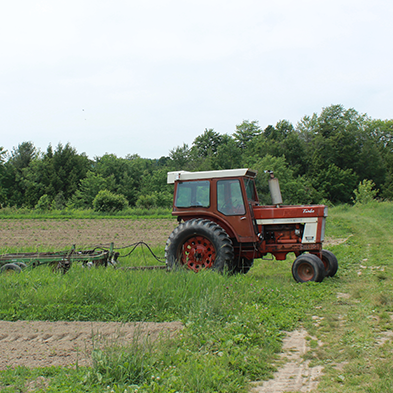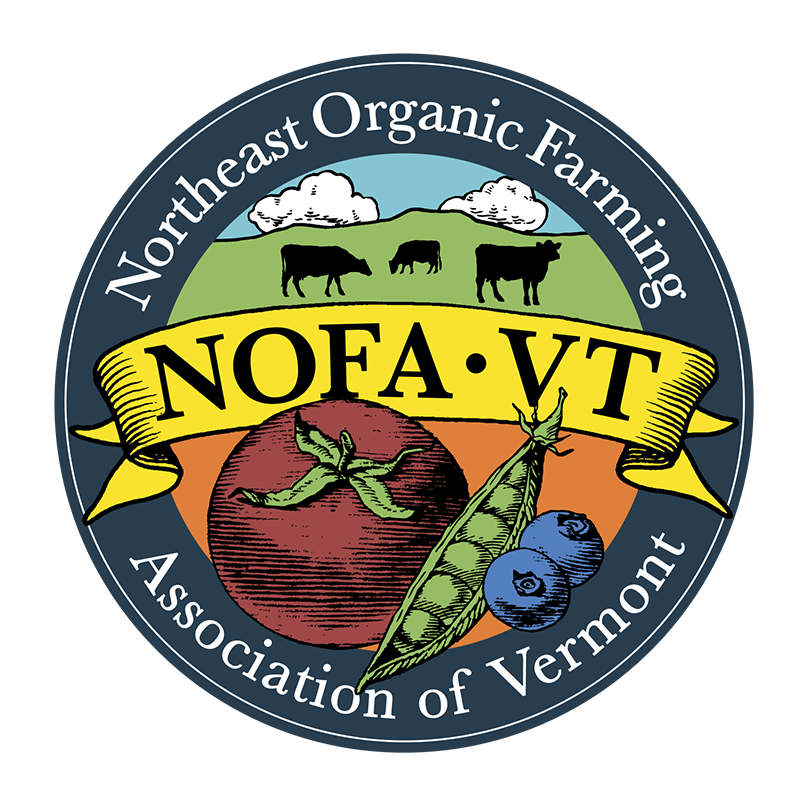Earlier this month, after much debate, the Farm Bill Conference Committee came out with a compromise package that was passed by the Senate (87-13) and the House (386-47). The new Farm Bill, which the President is expected to sign, contains many wins for organic, local and regional food systems, and avoids many of the most damaging proposed changes to nutrition and conservation programs. At the same time, the bill has been largely viewed as maintaining the status quo and continuing to tip the scales in favor of industrial agriculture overall.
Read on for a breakdown of how some of NOFA-VT’s priorities fared in the final Farm Bill. Looking for a deeper dive into one of the issues below? See the bottom of this post for links to additional Farm Bill reading from our national partners.

Organic Programs
Organic Research – The final Farm Bill reauthorizes the Organic Agriculture Research and Extension Initiative (OREI) and provides mandatory funding ($50 million/year) for the program by 2023, guaranteeing funding in future Farm Bill Debates.
Organic Certification Cost-Share Program – After the House version had sought to eliminate the National Organic Certification Cost Share Program (NOCCSP) completely, we are relieved that this Farm Bill renews funding for the program, which is critical in helping organic farmers afford organic certification costs.
Organic Integrity and Enforcement – The final bill increases funding for the National Organic Program (NOP) to $16.5 million in fiscal year 2019 with additional increases each year up to $24 million in 2023. In addition to increasing funding for the NOP, this Farm Bill includes improvements to ensuring the integrity of the USDA organic seal by adding measures to help prevent fraudulent organic imports.
Organic Data Initiatives Program – The final Farm Bill reauthorizes the Organic Production and Market Data Initiatives and provides $10 million in mandatory one-time funding, which will allow for continued organic data collection and distribution of organic market information.
National Organic Standards Board – This Farm Bill contains two unfortunate provisions impacting the NOSB, which we fought against. One of these codifies an Obama-era change in "sunset policy", making it more difficult to remove materials from the National List once they are added. The second is a provision that allows "employees" to fill the farmer and handler seats on the NOSB, which could lead to employees of large "farming corporations" serving in the farmer seat rather than owner/operators themselves.
Local & Regional Food Systems
Local Agriculture Market Program (LAMP) – The final bill merges the Value-Added Producer Grants Program (VAPG) and the Farmers Market and Local Food Promotion Program (FMLFPP) into the new Local Agriculture Market Program (LAMP). It also provides the new LAMP program with $50 million in mandatory funding in 2023, guaranteeing funding in future Farm Bills. FMLFPP in particular has been a critical source of funding for NOFA-VT’s work around promoting direct markets and supporting farmers that depend on them.
One challenging outcome related to this program is that it now includes a 25% match requirement, meaning organizations applying for FMPP/LFPP funding will have to match 25% of the request with other funding sources.
Specialty Crop Block Grants – The Farm Bill reauthorizes Specialty Crop Block Grants (SCBG), which enhance the competitiveness of so-called “specialty products”, meaning fruit, vegetables, and nuts. SCBGP funds can support a wide array of projects such as value-added processing businesses, food hub development, farmer food safety training, and farm to school initiatives.
Beginning & Socially Disadvantaged Farmers
The final Farm Bill report combines the Beginning Farmer and Rancher Development Program (BFRDP) and Section 2501 (Outreach and Assistance for Socially Disadvantaged and Veteran Farmers and Ranchers) into a new program called the Farming Opportunities Training and Outreach Program (FOTO) and provides baseline (i.e. guaranteed) funding at $50 million/year.
Nutrition & Food Access Programs
EBT at Farmers Markets – The final bill includes language directing USDA’s Food and Nutrition Service (FNS) to eliminate their "one machine, one location" policy for EBT machines at Farmers Markets. This policy has caused problems for Farmers Markets in Vermont where, for example, the same staff operates a summer market in one location and a winter market in another location, and has not been allowed to use the same EBT machine at both. Language in the new Farm Bill will allow markets to operate one EBT machine at more than one location under the same SNAP number. Report language was also included directing FNS to ensure EBT service isn’t disrupted, as was threatened for thousands of markets across the country (including many in Vermont) earlier this year.
Supplemental Nutrition Assistance Program – The House version of the Farm Bill made cuts to benefits and eligibility in SNAP, which would have kicked millions of Americans off nutrition assistance. Thankfully, the final Farm Bill rejected those cuts and instead maintains strong support for SNAP (renamed 3SquaresVT in Vermont). The final agreement also includes mandatory funding the Food Insecurity Nutrition Incentive (FINI) program, which helps improve access to fresh fruit and vegetables for SNAP participants. Also made it easier for retailers to participate in things like crop cash, whereas it was intended for direct markets specifically. The conference agreement also maintains a provision to make it easier for farmers markets to accept SNAP benefits.
Dairy Programs
Dairy Margin Coverage (DMC) replaces the Margin Protection Program (MPP). Specific changes to the program include the following:
- Farmers can simultaneously be enrolled in the new Dairy Margin Coverage (DMC) and Risk Management Agency (RMA) programs- Livestock Gross Margin (LGM-Dairy) and Dairy Revenue Protection (Dairy-RP). Farmers that were enrolled in LGM and ineligible for MPP in 2018 can now retroactively enroll in MPP-Dairy.
- Production history remains the same, based on highest annual milk production marketed in 2011, 2012, or 2013.
- Coverage Level Percentage (the percentage of a producer’s production history they choose to enroll in the program) has expanded to 5% of production history to 95% (vs. 25% to 90% in MPP).
- The quantity threshold that separates Tier 1 and Tier 2 remains at 5 million pounds (this was increased from 4 million pounds under the Bipartisan Budget Act).
- The Coverage Level Thresholds (the dollar value of the Actual Dairy Producer Margin, ADPM, that the farmer chooses as the threshold at which benefit payments will be made) are increased in Tier 1, with the addition of $8.50, $9, and $9.50 margin thresholds.
- There is an annual 25% premium discount for farmers that enroll and commit to DMC for the full five years of the program, at the same Coverage Threshold and percent of production history.
- To make up for the lack of payments from the 2014-2017 MPP, the DMC has a credit for farmers that were enrolled: 75% of the total premiums paid under MPP minus the total benefits received. This credit can be used towards new 2019 premiums or later. OR a farmer can request 50% of that difference as a cash refund.
For more information about the new DMC program, Dairy Markets and Policy provided a summary. If you have questions about this new program, contact your local FSA office. Enrollment should open by March 1st, 2019. Keep an eye out for updates from NOFA.
Other Important Issues
Addressing Maple and Honey Producers’ Added-Sugar Concerns – The bill exempts pure maple syrup and honey from the Food and Drug Administration’s “Added Sugar” Label Rule.
Hemp Farming – The final Farm Bill designates industrial hemp as an agricultural commodity and removes it from the federal list of controlled substances. The Farm Bill allows states to regulate industrial hemp, ensures that hemp growers can apply for grants from the USDA and that they will be eligible for crop insurance, and agricultural and academic research relating to industrial hemp.
Local Pesticide Regulations – The House version of the Farm Bill contained a provision that would have preempted local pesticide regulation and disallowed states from having stricter regulations than federal ones. The final bill excluded this provision, thereby maintaining current levels of local control of pesticide regulations.
Questions about a particular part of the Farm Bill? Email NOFA-VT Policy Advisor Maddie Kempner at [email protected].
Additional Farm Bill Reading:
- National Sustainable Agriculture Coalition (NSAC) Blog: Check out NSAC's "Farm Bill Drill Down" Series
- National Organic Coalition (NOC) Summary
- Organic Farmers Association (OFA) Summary
- Farmers Market Coalition (FMC) Analysis
- Dairy Summary from Vermont Milk Commisson (pdf)

